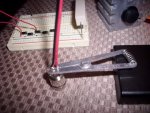- Joined
- Oct 9, 2010
- Messages
- 66
- Points
- 0
Hi all,
I searched for this on the forum, but couldn't find anything, so here is the question:
I've heard that laser diodes are very sensitive, so I'm figuring I should be using a soldering heatsink to attach to the leads in between the diode and the metal to be heated up and soldered...
Anyone have any recommendations?
I searched for this on the forum, but couldn't find anything, so here is the question:
I've heard that laser diodes are very sensitive, so I'm figuring I should be using a soldering heatsink to attach to the leads in between the diode and the metal to be heated up and soldered...
Anyone have any recommendations?






